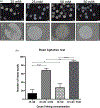Effect of alginate matrix engineered to mimic the pancreatic microenvironment on encapsulated islet function
- PMID: 33270214
- PMCID: PMC8887826
- DOI: 10.1002/bit.27641
Effect of alginate matrix engineered to mimic the pancreatic microenvironment on encapsulated islet function
Abstract
Islet transplantation is emerging as a therapeutic option for type 1 diabetes, albeit, only a small number of patients meeting very stringent criteria are eligible for the treatment because of the side effects of the necessary immunosuppressive therapy and the relatively short time frame of normoglycemia that most patients achieve. The challenge of the immune-suppressive regimen can be overcome through microencapsulation of the islets in a perm-selective coating of alginate microbeads with poly-l-lysine or poly- l-ornithine. In addition to other issues including the nutrient supply challenge of encapsulated islets a critical requirement for these cells has emerged as the need to engineer the microenvironment of the encapsulation matrix to mimic that of the native pancreatic scaffold that houses islet cells. That microenvironment includes biological and mechanical cues that support the viability and function of the cells. In this study, the alginate hydrogel was modified to mimic the pancreatic microenvironment by incorporation of extracellular matrix (ECM). Mechanical and biological changes in the encapsulating alginate matrix were made through stiffness modulation and incorporation of decellularized ECM, respectively. Islets were then encapsulated in this new biomimetic hydrogel and their insulin production was measured after 7 days in vitro. We found that manipulation of the alginate hydrogel matrix to simulate both physical and biological cues for the encapsulated islets enhances the mechanical strength of the encapsulated islet constructs as well as their function. Our data suggest that these modifications have the potential to improve the success rate of encapsulated islet transplantation.
Keywords: alginate; diabetes; extracellular matrix; hydrogel; islet transplantation; microencapsulation.
© 2020 Wiley Periodicals LLC.
Conflict of interest statement
CONFLICT OF INTERESTS
The authors declare that there are no conflict of interests.
Figures





References
-
- Alberts B, Johnson A, Lewis J, Raff M, Roberts K, & Walter P (eds). The extracellular matrix of animals. In: Molecular Biology of the Cell. 4th ed (2002). Garland Science.
-
- Badylak SF, Freytes DO, & Gilbert TW (2009). Extracellular matrix as a biological scaffold material: Structure and function. Acta Biomaterialia, 5(1), 1–13. - PubMed
Publication types
MeSH terms
Substances
Grants and funding
LinkOut - more resources
Full Text Sources

